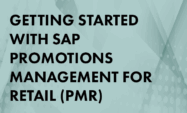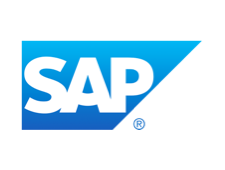SAP Trade Promotion Management
Filter By
Browse By
- SAP Analytics and AI
- SAP Application Development and Integration
- All SAP Application Development and Integration
- SAP ABAP
- SAP ABAP Development Tools
- SAP ABAP Test Cockpit
- SAP API Management
- SAP BAPI
- SAP Basis
- SAP BRF
- SAP Business Application Studio
- SAP CMS
- SAP Design Studio
- SAP Development Tools
- SAP DevOps
- SAP EAI
- SAP EDI
- SAP Extension Suite
- SAP Fiori
- SAP Fiori Elements
- SAP Integration Suite
- SAP Low Code Application Development
- SAP Low Code Automation
- SAP Netweaver
- SAP Release Management
- SAP UI5
- SAP Web Application Server
- SAP Web IDE
- SAP Business Process Management
- SAP Center of Excellence
- SAP CIO
- SAP Customer Experience
- SAP Data and Data Management
- All SAP Data and Data Management
- SAP BW
- SAP BW/4HANA
- SAP Crystal Reports
- SAP Data Archiving
- SAP Data Center
- SAP Data Governance
- SAP Data Integration
- SAP Data Migration
- SAP Data Quality
- SAP Data Services
- SAP Data Strategy
- SAP Data Visualization
- SAP Data Warehouse Cloud
- SAP DMS
- SAP Document Control
- SAP EIM
- SAP ETL
- SAP ETL Tools
- SAP HANA
- SAP HANA Administration
- SAP HANA Deployment Infrastructure
- SAP HANA Studio
- SAP Master Data
- SAP Master Data Governance
- SAP MDM
- SAP Enterprise Architect
- SAP Enterprise Asset Management
- SAP ERP
- SAP Finance
- All SAP Finance
- SAP Accounting
- SAP AR AP
- SAP Asset Accounting
- SAP Billing Systems
- SAP BPC
- SAP BRIM
- SAP Cash Management
- SAP Central Finance
- SAP Controlling
- SAP COPA
- SAP Cost Center Accounting
- SAP Currency Risk
- SAP e-invoicing
- SAP FICO
- SAP Finance Automation
- SAP Advanced Financial Closing
- SAP Financial Consolidation
- SAP Financial Planning
- SAP FX Risk
- SAP General Ledger
- SAP Global Tax Management
- SAP Hyperion
- SAP Order to Cash
- SAP Payment Processing
- SAP Profitability Analysis
- SAP Rebate Management
- SAP S/4HANA Finance
- SAP SWIFT Compliance
- SAP Treasury Management
- SAP Universal Journal
- SAP Governance Risk and Compliance
- SAP Human Capital Management
- SAP Intelligent Technologies
- SAP Platform and Technology
- All SAP Platform and Technology
- SAP Business Technology Platform
- SAP Cloud
- SAP Cloud Connector
- SAP Cloud Integration Platform
- SAP Cloud Migration
- SAP Cloud Platform
- SAP Cloud Providers
- SAP Cloud Strategy
- SAP Digital Signature
- SAP Container Platform
- SAP HANA Enterprise Cloud
- SAP Digital Asset Management
- SAP Smart Forms
- SAP HEC
- SAP Digital Integration Hub
- SAP Hyperscalers
- SAP Infrastructure
- SAP Messaging
- SAP Quality and Testing
- SAP Security
- SAP Spend Management
- SAP Supply Chain Management
- All SAP Supply Chain Management
- SAP APO
- SAP Asset Management
- SAP Business Network
- SAP Digital Manufacturing Cloud
- SAP Digital Twin
- SAP EWM
- SAP IBP
- SAP Inventory Management
- SAP Label Printing
- SAP Logistics
- SAP Manufacturing
- SAP Manufacturing Automation
- SAP MES
- SAP MII
- SAP MM
- SAP MRO
- SAP MRP
- SAP Order Management
- SAP Plant Maintenance
- SAP PLM
- SAP Production Planning
- SAP S&OP
- SAP SD
- SAP SPM
- SAP Supply Chain Planning
- SAP Track and Trace
- SAP Transportation Management
- SAP System Administration
What is Trade Promotion Management?
Trade Promotion Management (TPM) is focused on strategizing which promotional events have the greatest customer return on the invested marketing dollars. To determine this, companies must capture the expected promotional events, their costs, and the anticipated uplift.
Manufacturers and retailers require real-time visibility into their trade promotion landscape and adjust supply and demand parameters as business scenarios change. Through trade promotion, companies can expand their market share of specific products, better compete against competitors, and increase their retail partners.
With the use of technology, companies can optimize their trade promotion management by:
- Improving sales planning and budgeting
- Optimizing customer business planning
- Strengthening promotional planning
- Supporting execution and settlement
Key Considerations for SAPinsiders
What is Trade Promotion Management?
Trade Promotion Management (TPM) is focused on strategizing which promotional events have the greatest customer return on the invested marketing dollars. To determine this, companies must capture the expected promotional events, their costs, and the anticipated uplift.
Manufacturers and retailers require real-time visibility into their trade promotion landscape and adjust supply and demand parameters as business scenarios change. Through trade promotion, companies can expand their market share of specific products, better compete against competitors, and increase their retail partners.
With the use of technology, companies can optimize their trade promotion management by:
- Improving sales planning and budgeting
- Optimizing customer business planning
- Strengthening promotional planning
- Supporting execution and settlement
Key Considerations for SAPinsiders
- Improve effectiveness of trade dollars and supply chain by linking products in orders to specific promotions. According to Michael Debevec, President of Debevec Consulting, Inc., companies using TPM assign attributes to promotional spending that help them analyze actual results and compare the actuals to the original plans. “You assign each promotional event an identifier that you link to a new type of condition record, a campaign determination record,” he writes. “During order processing, you use the combination of customer, product, and date to determine if an active promotion is available. If one is available, the system stores the promotion identifier with the sales order line item.” Read the full article to learn more about the SAP TPM landscape and key system components.
- Avoid supplier stockouts by integrating trade promotion management with demand management planning. Planning a trade promotion with a retailer means ensuring product is available to meet expected demand. Not doing so leads to customer dissatisfaction and impacts to brand reputation and future sales. Manoj Ambardekar, an SAP subject matter expert with more than 20 years of IT and manufacturing experience, says to avoid stockouts, you need to determine the promotion uplift — the expected increase in demand beyond the baseline forecast. Doing so provides the total demand for a promotion. “TPM helps managers create a trade planning structure and gain visibility into trade promotions. Managers can identify the most profitable customers, fastest-moving product groups, and most effective types of promotions (e.g., end-of-aisle displays or front-page ads),” he writes. Read the full article to learn the configuration steps of a business scenario for a trade promotion.
620 results
-

 Premium
Premium
10 History Cleansing Best Practices for Reliable Statistical Forecasting
Reading time: 19 mins
Generate the most reliable and accurate sales data history for your statistical forecasting as part of your SAP Advanced Planning & Optimization Demand Planning project. See how to implement an efficient and effective history cleansing process. Key Concept The baseline history of a product is its normal historical demand without promotion, external stimulation, or any other abnormal...…
-

 Premium
Premium
Discover the Financial Aspects of Trade Compliance with GRC Global Trade Services
Reading time: 15 mins
Although SAP GRC Global Trade Services works very closely with logistics and interfaces with supply chain processes, it affects Financial Accounting in a number of ways as well. Learn how the functionality affects finance functionality and features directly and indirectly. Key Concept GRC Global Trade Services supports the production of international shipping documentation, including commercial...…
-

Getting Started with SAP Promotion Management for Retail (PMR)
Reading time: 3 mins
SAP Promotion Management for Retail (PMR) is a centralized application that enhances promotional strategies for retailers by optimizing planning, execution, and analysis of campaigns to drive sales, improve customer experience, and foster collaboration among teams.
-
-

 Premium
Premium
Manage NAFTA Trade Preference to Mitigate Risk with SAP BusinessObjects Global Trade Services
Reading time: 18 mins
In growing globalization, free trade agreements provide a comparative advantage for companies engaged with business within a specific trade zone. Implementation of the North American Free Trade Agreement (NAFTA) with SAP BusinessObjects Global Trade Services creates a combined solution to mitigate risk, better manage the process life cycle, and automatically deliver NAFTA certificates to customers....…
-

- SAP Process Analysis
 Premium
Premium
Gauge a Company’s Risk Exposure Using Market Risk Analyzer
Reading time: 31 mins
Learn how to implement SAP’s Market Risk Analyzer. The analysis reports in Market Risk Analyzer help an organization or, more specifically, a treasury department, to assess and quantify the risks of its financial positions. Once the risks of an organization are analyzed and quantified, they can be more easily controlled. The inputs to Market Risk...…
-

 Premium
Premium
Set Up Preference Processing to Delineate Customs Tariff Priorities and Manage Risk with Global Sourcing
Reading time: 19 mins
This walk-through of the configuration steps for Preference Processing within SAP GRC Global Trade Services Risk Management shows how to address tariff preferences in your trade application and systems. It includes setting up the communication between SAP GRC Global Trade Services and SAP ERP Central Component. Key Concept Duty and restriction applies to goods imported...…
-

 Premium
Premium
Manage Global Trade Restitution Laws and Demands Using SAP BusinessObjects Global Trade Services 8.0
Reading time: 15 mins
Learn how SAP BusinessObjects Global Trade Services handles the restitution process in the European Union. Understand how to configure restitution functionality in SAP BusinessObjects Global Trade Services 8.0 through a step-by-step configuration checklist. Key Concept SAP BusinessObjects Global Trade Services allows you to export agricultural products from the European Union (EU) to non-EU countries by...…
-
-

 Premium
Premium
Meet Your EU Compliance Requirements by Enabling Electronic Intrastat Reporting
Reading time: 24 mins
Learn how to configure SAP ERP Central Component for identification and transfer of transactions for Intrastat reporting to SAP BusinessObjects Global Trade Services. Then you can set up SAP Electronic Compliance Reporting (SAP ECR) for reporting on goods shipped within and outside the European Union. Key Concept SAP Electronic Compliance Reporting (SAP ECR) is a...…
-

- SAP HANA
 Premium
Premium
Colgate-Palmolive Combines Its Trade Promotion Planning with SAP HANA
Reading time: 6 mins
As a producer of some of the most recognizable personal and home care brands in the world, Colgate-Palmolive is consistently exceeding the expectations of its global customer base. This statement holds just as true for the technology the company uses; it has consistently been a pilot customer for SAP applications that eventually become mainstream solutions....…
-

 Premium
Premium
Automate Your Import Filing to Reduce Compliance Costs with SAP BusinessObjects Global Trade Services
Reading time: 21 mins
Companies have to deal with the import of goods into their country and the declarations that go along with importing. To improve on efficiency, reduce costs in your compliance process, and avoid delays in customs clearance, you can automate your import declarations using functionality in SAP BusinessObjects Global Trade Services. Key Concept Import filing to...…
Become a Member
Unlimited access to thousands of resources for SAP-specific expertise that can only be found here.
Become a Partner
Access exclusive SAP insights, expert marketing strategies, and high-value services including research reports, webinars, and buyers' guides, all designed to boost your campaign ROI by up to 50% within the SAP ecosystem.
Upcoming Events
Related Vendors
Your request has been successfully sent


